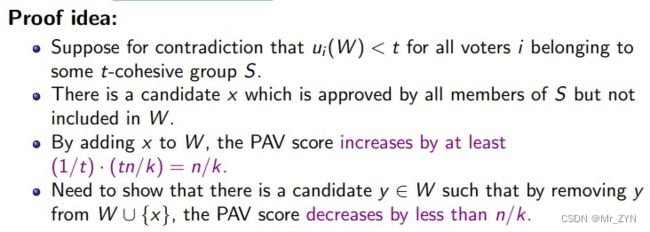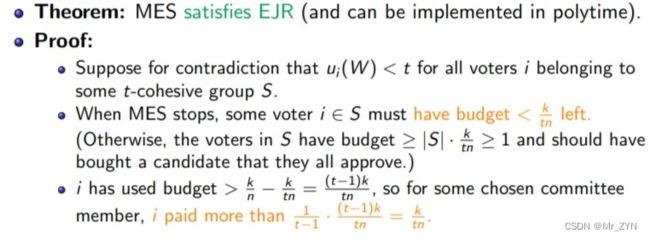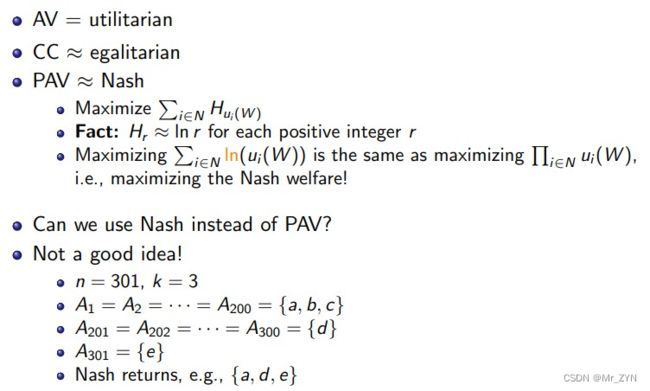NUS-CS5461 Week11: Committee Voting
1. Approval Committee Voting
Voters: N = { 1 , 2 , ⋯ , n } N=\{ 1, 2, \cdots, n\} N={1,2,⋯,n}
Candidates C, where |C| = m
Voter i approves a set of candidates A i ⊆ C A_i \subseteq C Ai⊆C
We want to choose a committee W of size k, where k ≤ m k \le m k≤m is given
Voter i’s utility is u i ( W ) = ∣ A i ∩ W ∣ u_i(W ) = |A_i \cap W | ui(W)=∣Ai∩W∣
Symbol Meaning:
N: Voters set
n: voters number
C: Candidates set
m: Candidates number
A i A_i Ai: The set of candidates that voter i approves A i ⊆ C A_i \subseteq C Ai⊆C
W: Committee set
k: Committer members number
u i ( W ) = ∣ A i ∩ W ∣ u_i(W ) = |A_i \cap W | ui(W)=∣Ai∩W∣: Voter i’s utility, 投票者i所投的候选人与入选委员会的候选人的交集
2. Social welfare
Total number of approvals obtained by members of the committee (“excellence”)
委员会中所有成员获得的票数的总和。最大化所有投票人的utility。
3. AV: Approval Voting
Select a committee maximizing social welfare
选择一个所有成员的得票数总和最大的委员会。满足功利主义(Utilitarian)
求法:按照得票数高低从大到小依次将候选人加入委员会中
易错点:注意有可能出现 A 5 = A 6 = { e , f } A_5 = A_6 = \{e, f\} A5=A6={e,f} 的情况,少算一个情况。遇到这种题,把重复的行标注上 乘以几次
4. Coverage
Number of voters who approve at least one committee member (“diversity”)
该委员会有多少投票人支持(至少支持其中一个委员会成员的投票人的数量)
Cover: If a voter approves a candidate, we say that the candidate covers the voter. (解释:一个候选人被这个投票者支持,就代表候选人cover他)
5. CC: Chamberlin–Courant
Select a committee maximizing coverage
求法:选择一个能够覆盖最多投票者的委员会。(不能在polynomial time内计算,是NP-Hard的)
目的:尽量使utility为0的人最少(约等于平等主义,egalitarian)
Neither above feels “proportional”
Intuition of proportionality: A sufficiently large group of voters that agrees on sufficiently many candidates should be correspondingly satisfied in the committee.
6. JR: Justified Representation
Settings: n voters, k committee slots, a group of $ n \over k$ voters “deserve” one slot.
Cohesive Group: a group of voters S ⊆ N S\subseteq N S⊆N such that ∣ S ∣ ≥ n k |S|\ge {n \over k} ∣S∣≥kn and ∣ ∩ i ∈ S A i ∣ ≥ 1 |\cap_{i \in S}A_i| \ge 1 ∣∩i∈SAi∣≥1. (有凝聚力的团队,定义:一个投票人团队的人数大于等于投票人总数与委员会席位之比,而且内部至少对支持一个候选人达成共识(现在与委员会还无关),这样的投票人团队被称为cohesive group)
Justified Representation (JR): For any cohesive group of voters S ⊆ N S\subseteq N S⊆N, there exists i ∈ S \color{red}\text{there exists}~i \in S there exists i∈S such that ∣ A i ∩ W ∣ ≠ ∅ |A_i \cap W| \neq \empty ∣Ai∩W∣=∅.
(合理代表,解释:对于任意cohesive group,如果其中至少存在一个投票者的utility不为0,也是在委员会中至少有一个候选人是他支持的,就称该Committee满足Justified Representation (JR)。cohesive group应该得到代表)No cohesive group should go unrepresented.
AV may fail JR.
CC always satisfied JR.
Proof:

(Source: NUS CS5461 week 11 lecture slides, page 10)
7. GreedyCC (Greedy Variant of CC)
Motivation: Computing a CC committee is NP-hard. (引入GreedyCC的动机)
Method:
-
Start with an empty set of candidates.
-
In each step, choose a candidate that covers as many uncovered voters as possible. 注意每次都是选出能够覆盖从未被覆盖的投票人的候选人
-
Repeat this until k candidates have been chosen.
Notation: The coverage of GreedyCC is worse than CC committee.
Greedy CC satisfied JR. (Proof is below)

(Source: solutions for assignment 11)
8. EJR: Extended Justified Representation
Motivation: JR is not sufficient
- n = 100, k = 10
- A1 = A2 = · · · = A50 = {a1, a2, . . . , a10}
- A51 = A52 = · · · = A100 = {b1, b2, . . . , b10}
- Does W = {a1, a2, . . . , a9, b1} satisfy JR? Yes.
- But {a1, a2, . . . , a5, b1, b2, . . . , b5} feels much more “proportional”!
T-Cohesive Group: For a positive integer t \color{red}{t} t, a group of voters S ⊆ N S\subseteq N S⊆N such that ∣ S ∣ ≥ t ⋅ n k |S|\ge {\color{red}{t}} \cdot {n \over k} ∣S∣≥t⋅kn and ∣ ∩ i ∈ S A i ∣ ≥ t |\cap_{i \in S}A_i| \ge \color{red}{t} ∣∩i∈SAi∣≥t. (解释:一个投票人团体的人数大于等于n/k的t倍,且他们内部至少对t个候选人的支持达成共识,则这个团体就成为t-cohesive group。两个条件:团体总人数大于n/k的t倍,且有t个共同支持的委员会成员)
Extended Justified representation (EJR): For any positive integer t and **any **t-cohesive group of voters S ⊆ N, there exists i ∈ S i \in S i∈S such that ∣ A i ∩ W ∣ ≥ t |A_i \cap W | \ge t ∣Ai∩W∣≥t.
(扩展合理代表,解释:对于任意正整数 t 和任意 t-cohesive group,如果至少存在一个投票者的utility大于等于t,也是在委员会中至少有t个候选人是他支持的,就称该Committee满足EJR。要求:t是任意的。JR是EJR的特殊情况,也就是t=1的情况)
9. PAV: Proportional Approval Voting
Fix an infinite nonincreasing sequence s1,s2, . . .
Thiele methods: Choose a committee W maximizing the score
∑ i ∈ N ( s 1 + s 2 + ⋯ + s u i ( W ) ) \sum_{i\in N}(s_1+s_2+\cdots+s_{u_i(W)}) i∈N∑(s1+s2+⋯+sui(W))
公式可化为 ∑ i ∈ N ∑ j = 1 u i ( W ) s j \sum_{i\in N}\sum^{u_i(W)}_{j=1}s_j ∑i∈N∑j=1ui(W)sj , 其中右边的求和是对于某个投票人i的, s j s_j sj是投票人i对委员会中第一个他支持的成员的打分(打分的值后面会自定义),依次加到最后一个他支持的委员会中的成员(排名不分先后),总数就是他对委员会W的utility: u i ( W ) u_i(W) ui(W),也就是委员会中他支持的成员的总数。左边的求和是对于所有投票人的,将每一个投票人计算出右边的值,然后再加和。Thiele methods是为了选择一个最大化这个公式值的委员会。
Proportional Approval Voting (PAV): s i = 1 / i s_i = 1/i si=1/i for all i, 也就是定义将上面的公式中打分s的计算方法。(proportional的AV,因为原始的AV并不满足JR和EJR)
If a voter approves r candidates in the committee, the voter contributes 1 + 1 2 + ⋯ + 1 r 1 + {1 \over 2} + \cdots + {1 \over r} 1+21+⋯+r1 (r-th harmonic number, denoted by H r H_r Hr) to the score of the committee.
The motivation of Harmonic Numbers is to make harmonic numbers result in a roughly “proportional” committee. 目的就是为了得到更加大致符合proportional的委员会。
PAV委员会的求法:列出所有的候选人的得分,按着得分从大到小依次选取候选人到委员会。
计算委员会的PAV得分是,也就是使用Thiele Methods,依次计算每个投票人对委员会所有成员的打分之和(1+ 1/2 + …),然后再将所有投票人的打分和相加。

(source: NUS CS5461 Week11 Lecture Slides, page 15)
PAV and Nash
PAV satisfies EJR

(Source: NUS CS5461 Week11 Lecture Slides, page 17)
PAV is NP-hard to compute
A greedy variant of PAV does not even satisfy JR.
10. MES: Method of Equal Shares
Motivation: satisfy EJR in polynomial time.
Method:
- Each voter has a budget of k/n.
- Each candidate costs 1; the voters who approve this candidate have to “pool” their money to add this candidate to the committee.
- Start with an empty committee.
- In each round, we want to add a candidate whose approved voters have a total budget of ≥ 1 left.
- If there are several such candidates, choose one such that the maximum amount that any agent has to pay is minimized.
- If no more candidate can be afforded but the committee still has size < k, fill in the rest of the committee using some tie-breaking criterion (e.g., by maximizing approval score).
步骤解释:设定每个人有k/n的预算,k/n就是委员会席位与投票人总数的比值。每选出一个候选人成为委员会成员,就需要花费值为1的预算,这些钱需要所有支持这个候选人的投票人来支付。委员会的初始情况是空集。在每一轮中,我们只添加剩余预算总和大于1的投票人所支持的候选人到委员会中。如果同时有多个这样的候选人,就选出那个使投票人中支付预算最多的那个人所支付的预算最小的候选人。如果剩余的候选人所需的预算都不能被满足的话,打破平局的方法(tie-breaking)是:一般来说会选取获得更多人支持的候选人(by maximizing approval score)。
这里并不要求每次支付中的每个人所付的预算是一样的。
这里同样要注意 A4 = A5 = {c, d} 以及 A6 = A7 = {a, c}的情况,不要少算。

(Source: NUS CS5461 Week11 Lecture Slides, page 19)
MES never chooses more than k candidates
- Total budget of all n voters is (k/n) · n = k, and each candidate costs 1
MES satisfies EJR

(Source: NUS CS5461 Week11 Lecture Slides, page 20)
11. Summary
| JR | EJR | Polytime | |
|---|---|---|---|
| AV (maximizes welfare) | × \color{red}{\times} × | × \color{red}{\times} × | ✓ \color{green}{\checkmark} ✓ |
| CC (maximizes coverage) | ✓ \color{green}{\checkmark} ✓ | × \color{red}{\times} × | × \color{red}{\times} × |
| GreedyCC | ✓ \color{green}{\checkmark} ✓ | × \color{red}{\times} × | ✓ \color{green}{\checkmark} ✓ |
| PAV | ✓ \color{green}{\checkmark} ✓ | ✓ \color{green}{\checkmark} ✓ | × \color{red}{\times} × |
| MES | ✓ \color{green}{\checkmark} ✓ | ✓ \color{green}{\checkmark} ✓ | ✓ \color{green}{\checkmark} ✓ |
选出Committee的方法:AV, CC, GreedyCC, PAV
评价指标:JR, EJR
概念辨析
不能在polytime中算出(NP-hard)的是CC和PAV
唯一不符合JR的是AV;唯二满足EJR的是PAV和MES
EJR的定义比JR更强,JR是EJR的特殊情况(t=1)
PAV是为了让AV更符合proportional,但是不能在polynomial time中算出,也就是NP-hard。
GreedyCC是为了让CC能在polynomial time中算出,也就是满足NP-complete(与NP-hard相反),但是不如CC的coverage。
12. Exercise
(Source: practice problems for midterm 3 in the discussion forum on NUS Canvas)


